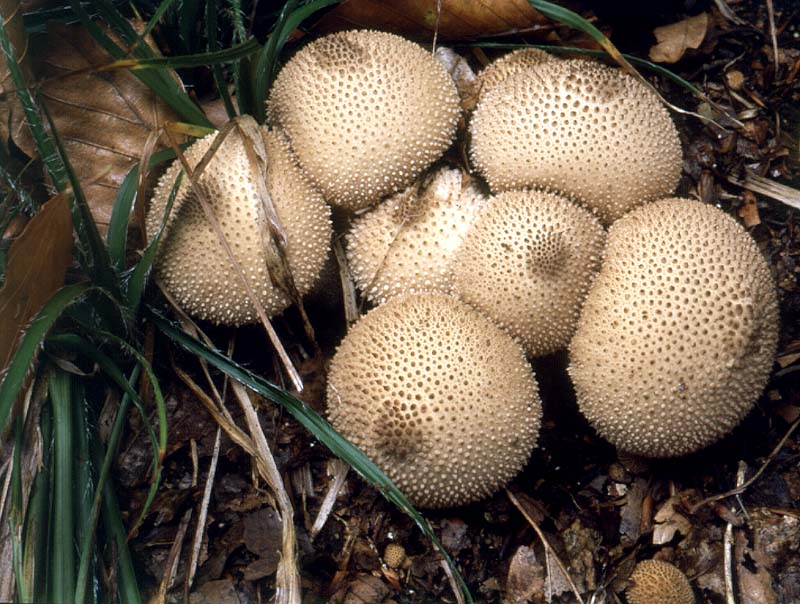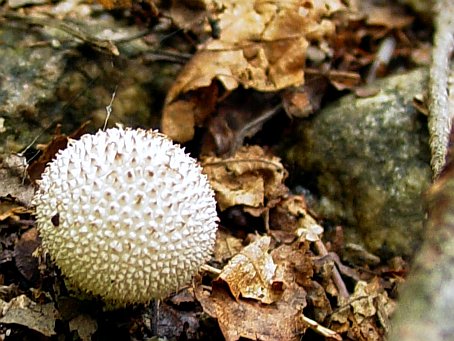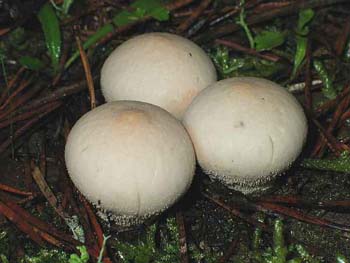Elite life

Mushrooms
Lycoperdon
║ Mushrooms ║
Gem-Studded Puffball, Devil's Snuff-Box (Lycoperdon perlatum)

Fruit body 2.5-6 cm across, 2-9 cm high, subglobose with a distinct stem, white at first becoming yellowish brown, outer layer of short pyramidal warts especially dense on the head, rubbing off to leave an indistinct mesh-like pattern on the inner wall which opens by a pore. Gleba olive-brown at maturity; sterile base spongy, occupying the stem. Spores olivaceous-brown, globose, minutely warted, 3.5-4.5 μm.
Venus Puffball (Lycoperdon mammiforme)

Fruit body 4-7cm across, 4-9 cm high, subglobose with a broad umbo, tapering into a short stem, white at first then ochre-brown, outer wall breaking into large white or creamy cottony scales and leaving a ring-like zone around the base of the swollen head, inner wall thin and papery, opening by a central pore. Gleba finally dark purplish-brown; sterile base spongy, well developed. Spores chocolate brown, globose, warted, 4-5 μm in diameter.
Lycoperdon marginatum, Lycoperdon candidum

Fruit body 1-5 cm high, globose, sometimes with a small rooting base; white becoming brownish; with an outer covering of pointed warts or spines, which fall away in irregular sheets, exposing the olive-brown inner wall, or endoperidium. Spore mass olive to gray-brown. Sterile base well developed, chambers about 1 mm across, capillitial threads 3-6 μm wide. Spores globose, minutely ornamented, olive-brown, 3.5-4.2 x 3.5-4.2 μm.
Lycoperdon molle

Fruit body 1-4 cm across, 6cm high, usually pear-shaped; grayish brown to milky-coffee colored; minutely spiny or granular. Spore mass white, dark brown in maturity; inner spore case opening by a wide, irregular pore. Sterile base has large chambers; sometimes wide and sometimes narrowed to a distinct stalk. Spores globose, 3.5-5 x 3.5-5 μm.
Black Puffball (Lycoperdon nigrescens, Lycoperdon foetidum)

Sporocarp: Fruiting body 2.0-4.0 cm tall, 2.5-3.0 cm broad, pear-shaped, tapering to a narrow sterile base; exoperdium blackish-brown, a mixture of straight or connivent, short spines and furfuraceous granules; endoperidium thin, membranous, buff-brown to ochre-brown; fruiting body dehiscing via an apical pore; gleba whitish, becoming yellowish-olive, in age dull olive-brown or dark ochre-brown, firm to elastic in texture; subgleba taking up to one half the fruiting body, finely chambered, pale grey to brown, sometimes tinged purple.
Spores: Spores 3-5.5 μm, globose to subglobose, thick-walled, echinulate, with a large central body, often with a short, 1 μm pedicel; spores dull olive-brown in deposit; capillitium slender, occasionally branched 3.0-5.5 μm thick, pores variable, mostly round to elongate.
Stump Puffball (Lycoperdon pyriforme, Morganella pyriformis)

Fruit body 1.5-4 cm across, 3.5 cm high, subglobose to club-shaped, attached to the substrate by mycelial strands, whitish at first finally yellowish- or greyish-brown, outer layer of scurfy spines, warts, or granules, inner wall becoming smooth and papery, opening by an apical pore. Gleba olive-brown; sterile base occupying the stem spongy, but the cavities forming rather small cells. Spores olive-brown, globose, smooth, 3-4 μm in diameter. Capillitium distinctive in being formed of brownish branched threads which lack all trace of tiny hyaline pores, all other members of the genus have poroid capillitial threads.
║ Mushrooms ║